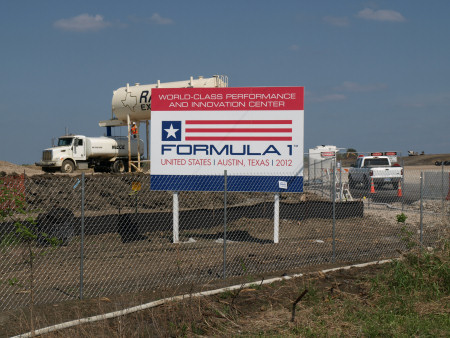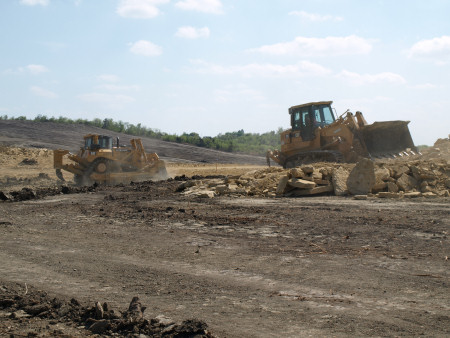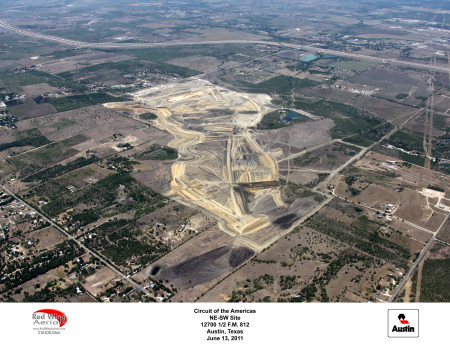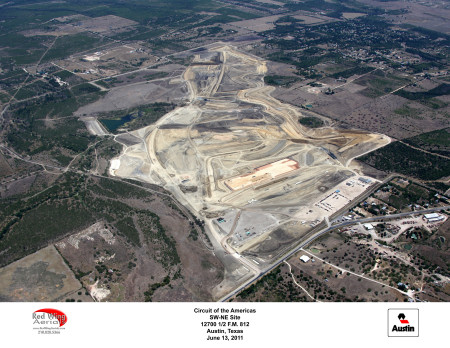The Way It Is/ Tavo Hellmund on F1 in Austin
by Gordon Kirby Tavo Hellmund's drive to bring the United States Grand Prix back to life at his Circuit of the Americas near Austin, Texas has created plenty of interest and opinion. Formula One cars have raced only once before in Texas at a Dallas street circuit on an infernally hot day in the summer of 1984. The race was never repeated as the promoter and most of the prize money disappeared and to many people Texas and Grand Prix racing is an oxymoron.
Tavo Hellmund's drive to bring the United States Grand Prix back to life at his Circuit of the Americas near Austin, Texas has created plenty of interest and opinion. Formula One cars have raced only once before in Texas at a Dallas street circuit on an infernally hot day in the summer of 1984. The race was never repeated as the promoter and most of the prize money disappeared and to many people Texas and Grand Prix racing is an oxymoron.
But when you meet Tavo Hellmund you cannot help being drawn in by his energy and enthusiasm. Hellmund quickly makes you a believer that the United States GP will find a permanently attractive home at his new track. He opens by pitching Austin's many appealing virtues.
"Austin used to be a cool, sleepy college town but today Austin is leading the recovery of the United States," Hellmund emphasizes. "There's just six percent unemployment in Austin and more money per capita than any city in the United States. The real estate market hasn't been effected by the recession and Kiplinger voted Austin the number one city in the United States for the next decade
"Geographically, it's really pretty. It's a little bit different from our wonderful Texas cities like Houston and Dallas. We're in the Hill Country with rivers and lakes and Austin also has one of the coolest nightlife and music scenes in the country.
"I've been around Grand Prix racing a long time and I think Austin is absolutely what the teams and the fans will enjoy and eat up. I think there's a bunch of places across the United States that are great places for international events and Austin has definitely become one of those places."
Turning to the Circuit of the Americas tight construction schedule, Hellmund is entirely frank in admitting that he and his team face a monumental task.

© Circuit of the Americas
"We've already spent thirty percent of the money it will cost to build it and we're tracking on schedule. All the grading and subterraneal stuff and infrastructure has been started. The tunnels are going in right now and we're going vertical in the next 30 days.
"We've been fortunate we're in a drought. The general public would like some rain in central Texas but for us the drought has been playing into our hands. Right now, so far so good. We're working absolutely flat-out with no rest."
There were suggestions during the Canadian GP weekend in Montreal that the Austin race may be moved back to November at the end of the 2012 season. That would not only help Hellmund's hectic construction schedule but also make for much more pleasant weather than the unrelenting 100 degree heat that envelopes most of Texas in June and July.
"We've got seventeen companies that are hired and involved in the project right now," Hellmund goes on. "All of them are Texas-based companies. We also have a Spanish architecture firm--Mauro-Riviera--that are doing the grand plaza, fan experience section of our track and obviously, we've got the German engineering firm Tilke. Kevin Schwantz and I designed the track with Tilke. We also have an American firm that is the architect of record because Tilke is not an American firm. I think in all there are 1,100 people working off and on the project.
"We know that the state and local government are real excited about the economic impact of our facility. The reports I've seen estimate the economic impact of the construction project to be around $400 million to the state when it's all said and done. So we're shooting with both barrels and just going as fast as we can."

© Circuit of the Americas
"There are going to be a lot of things that we're not going to be able to have finished by the first Grand Prix. I think I'd be misleading people by saying that we're going to have everything perfect. That won't be accurate. I think and hope that the fans understand that there will be some components that aren't exactly ironed-out. There are some things that will have to wait until 2013.
"Contractually, we have to have places for seating, grandstands, the medical and pit buildings, FIA fencing and communications and electronics. We certainly hope we can have most of our permanent facilities like concessions and restrooms. But if we're running short of time the stuff that isn't permanent will have to be temporary the first year until we can build it for the second race.
"I think most people can remember what many facilities were like for the first time. Texas Motor Speedway is a great sporting venue in our state and we're huge supporters of what they do. But it took them three or four years to get everything ironed out.
"So I hope that the public doesn't have selective memory. It'll probably be 2014 or '15 before we have everything exactly the way we want. But we feel that by next year we'll still have one heck of a place to come watch a sporting event. It will be good value for the money."
Although yet to be formally approved Hellmund believes the race will benefit from $25 million income from the state's special event hotel and meals tax.
"I think the detractors have been trying to mislead the public," he commented. "This is a fund that was created in 2003 by the Texas legislature to attract big events. This legislation was passed during the 2009 session and the SuperBowl used it in February and the Final Four used it in Houston in April so this is just an extension. It's a cost-neutral thing to the state. It's an incremental sales tax revenue that is created from that event and we're being allowed to keep a portion of it to help offset the costs of the event.
"I wish we could keep all of it and do that for every single event and we wish that other motorsports events qualified for that fund but unfortunately they don't. There are a lot of other great motorsports events in America that are certainly worthy of it but the way the statute is written Formula One is the one motorsport that qualifies for it right now. We're tracking it and we're right in the middle of the process for the major event trust fund."
Hellmund also says worries about access to the Circuit of the Americas have been overblown.
"I invite everyone to come down," he remarks. "I talked to Martin Brundle who said there were issues with that when we made our announcement last fall. In the motorsports world everyone's got an opinion, and it's funny when people talk about something and they've never even been there.

© Circuit of the Americas
"The road that leads from the toll road is four lanes and it has two exits so you can get to the other side of the property off the toll road and it leads to a four-lane highway. The east side of the property is just a two-lane road and there's about a half-mile stretch on the west side that is only a two-lane and those obviously need to be expanded. Those are private roads.
"We would love to have six-lane boulevards all the way around the facility. Right now, we've got either two lanes or four lane roads. Do we think that should be improved? Yes. Will they be improved for the first Grand Prx? No.
"But you look at Silverstone and they don't have much more than that and they've done a magnificent job with the way they handle the traffic flow. I think we're going to have to do some serious traffic management but all the analysis and studies we've had done think that if everyone left at the same time we could dump them in three hours. So that's pretty similar to a lot of sporting events and a lot of racetracks.
"We're going to do some things on-site after the Grand Prix that are going to help that. We're going to have activities that should encourage people to stay. We think that if we have a full house of 120,000 people it should be a trickle effect. It shouldn't be everyone leaving at once.
"The other thing we're doing is we are putting in our own five-lane boulevard right down the middle of the property connecting from Highway 812 to Elroy Road. They run north and south right down the middle of the property separating parking lots and so forth, and that's where we're putting in our own private five-lane boulevard."
Hellmund believes the Circuit of the Americas will prove to be a challenging and attractive track.
"We've got some awesome racetracks in America but I think we're building a track that is as close to an old throwback track that you can do today by the FIA standards. I think it's going to be one of the nicest road courses in the American hemisphere."
Hellmund is equally adamant that he's not a fan of today's wide and open F1 run-off areas.

© Circuit of the Americas
He has no doubts that it will take time to build F1's fan interest in America.
"I think it's going to be a long process," Hellmund admits. "We are so busy right now trying to build the track that we haven't been able to focus as much as possible on this. Hopefully, very shortly we will be able to roll out our entire integrated marketing plan and platform. I do think there is a hard-core, knowledgeable Formula One base in America that feels neglected or turned away and I think our job in trying to promote Formula One is three-fold.
"One is we need to raise the profile of Formula One in America and to educate the average, casual fan about F1. For the diehard fan I think we need to expand it and re-engage them. I think what unfortunately happened to open-wheel racing in America has disenchanted that fan to a great degree.
"But I've raced in NASCAR, I grew up and raced on short tracks and I've been around Grand Prix racing all my life. So I've promoted and been involved with a lot of different types of events and I am not a believer that you either like F1 or you like NASCAR and you don't like the other.
"I personally believe that if you are a true race fan you appreciate the art of each of those forms of racing. I don't care if it's a flat track on dirt or if you want to go to the Knoxville Nationals or the Chili Bowl, they are awesome to watch. And the same with watching a Formula One car through Eau Rouge at Spa, or the Audis and Peugeots at Le Mans, or NASCAR at Bristol in qualifying when you stand at turn one. All those things are pretty awesome to watch.
"So I think what we need to do is not try to sell a race but to sell a happening or an event because if you're going to try to elevate things to an international level, which is what Formula One has been able to do everywhere in the world, it can't be just about a Formula One race. It's got to be about that Austin--or where ever the host city is at that time--is the place to be.
"The Kentucky Derby has done an awesome job of that. It's two minutes of horse racing but it's three weeks of festivals leading up to it and it brings a huge impact to the community and the city. You don't have to be a horse racing fan to know that going to the Derby is a cool experience. So I think we need to promote a happening and, by the way, there happens to be a world championship-level motorsport event on Sunday that lasts two hours."
Clearly, Hellmund is a total racing fanatic and his enthusiasm and broad thinking should help him achieve his goals in Austin.
"I was asked by a television reporter if you could go to only one race in the world, which one would it be?" he remarked. "And I said I couldn't answer that. I'd rather have a week where I'd start off on Monday at the Chili Bowl, and on Tuesday I'd go to the Daytona 500 and so on through the week to the Indy 500, to Monaco, to Le Mans, to Spa, to the Knoxville Nationals. I'd go to them all. But there's no doubt that when you see a Grand Prix car on a qualifying lap in person at the track there's something that's so incredibly beautiful about the sound. It's unique.
"We know that Formula One has the largest following worldwide and it also has a big following in America. But today's consumer is basically ADD with so many options on your TV, your cellphone and computer. So I think we have to create a happening and an event. That's how you attract a broad audience and when they see the Formula One cars in action you get them engaged in the sport and wanting to come back.
"I think the other thing is we need stars. We don't need to promote Ferrari and McLaren. They need to promote Alonso and Hamilton. Lewis Hamilton should be the most famous athlete on the planet. He's a world champion, good-looking, articulate and he scores well with a global audience. I think he's got the potential to be more famous than Tiger Woods if he's marketed right."

© Circuit of the Americas
"From our standpoint this isn't about a Formula One facility," he says. "It just happens to be one of the crown jewels that we have. We want this to be a fan experience that men, women and children want to come to, not just the race fans or Formula One fans. We want to attract touring car fans and sports car fans. We plan to have four or five big events and use the facility year-round. We're not building a racetrack. We say internally, we're not building a racetrack, we're building a destination. We want people to come to enjoy it.
"As Texans we have to be very disciplined because we are so proud of ourselves, as we all know, and we love reminding the rest of the world that we were once our own country. But we knew that it would be a mistake to make this an iconic Texas thing. Hence the reason for the name of the facility.
"We want this to be something that everyone feels inclusive of and that everybody wants to go to. We want this to be something that all Americans and all Texans are proud of but we want the people in Latin America to really embrace it as well. I don't know if we will get it all right, but if we get more than fifty percent of it right I think we'll be okay."
He also plans to stage a wide range of other events, particularly music shows and concerts.
"We're obviously going to have a significant musical component. I've been involved in promoting events in the music industry and I've had partners in the music industry and obviously Austin and the music industry just go together. So we will have a lot of live outdoor music. We're working on a series we could do for local Austin musicians that we hope to unveil this summer.
"We have a lot of partnerships that we're trying to develop with universities with internships and where they can actually participate on-site. Things like landscaping with Texas A&M with some of the drought-resistent technologies they're working on which are some of the best in the United States. We're doing stuff with the engineering department at the University of Texas which owns the largest algae bank in the world. We've got some manufacturers that we think we can get involved not only on site with our facility but also to be truly connected with the university's engineering departments so that you triangulate it."
Hellmund believes his Full Throttle group's experience in promoting short track races in Texas will serve him well at the Circuit of the Americas.
"I took USAC back to Texas for the first time in many years," he relates. "There hadn't been an asphalt USAC midget race in Texas in forty years and I brought them back in 2006. Nobody wanted to buy a USAC midget ticket so I put them on the same card as NASCAR's Grand National series that used to be the Winston West. It was the only place in the country where you could see a NASCAR regional series race and a USAC midget race on the same day at the same track. We charged $25 general admission and they got two great races.
"I knew it was going to be tough to get the diehard NASCAR fans to go to a USAC midget race but it worked so well that the next year we didn't have to combine them. The USAC midget race sold on its own and on a short track they were much quicker than the NASCAR cars.
"So I think it's just letting the casual fan see the product. My wife is a diehard sports fan, not a big motor sports fan. I've taken her to all the big events but the first time she was up close to a Grand Prix car about six or seven years ago at Spa we were lucky enough to stand right on the guardrail at Eau Rouge and she said if every American could do what I'm doing there would be a huge following for F1 in America.
"I think the European mentality has always been that it doesn't matter if the winner wins by forty seconds. That's the point--to try to win by the biggest margin and show your dominance. In America, we want entertainment. So I think we have to mesh the two and I think it's pretty hard to argue against what we're getting in Formula One over the last couple of years. In my opinion, it's pretty darned good racing."
If Hellmund's passion and enthusiasm for the sport are indicators of what we will see at his track outside Austin we're sure to be in for a healthy treat. And if that comes to pass it will be a great thing for American motor racing.
Auto Racing ~ Gordon Kirby
Copyright 2011 ~ All Rights Reserved
Copyright 2011 ~ All Rights Reserved
Top of Page